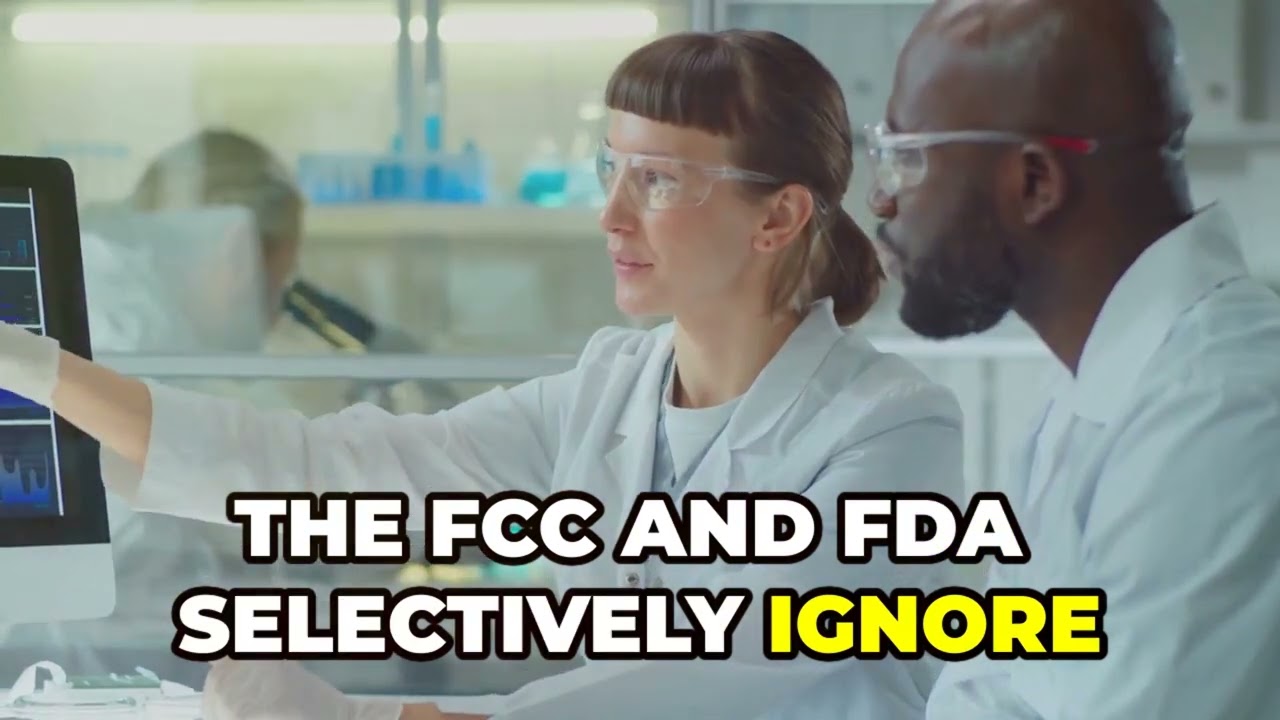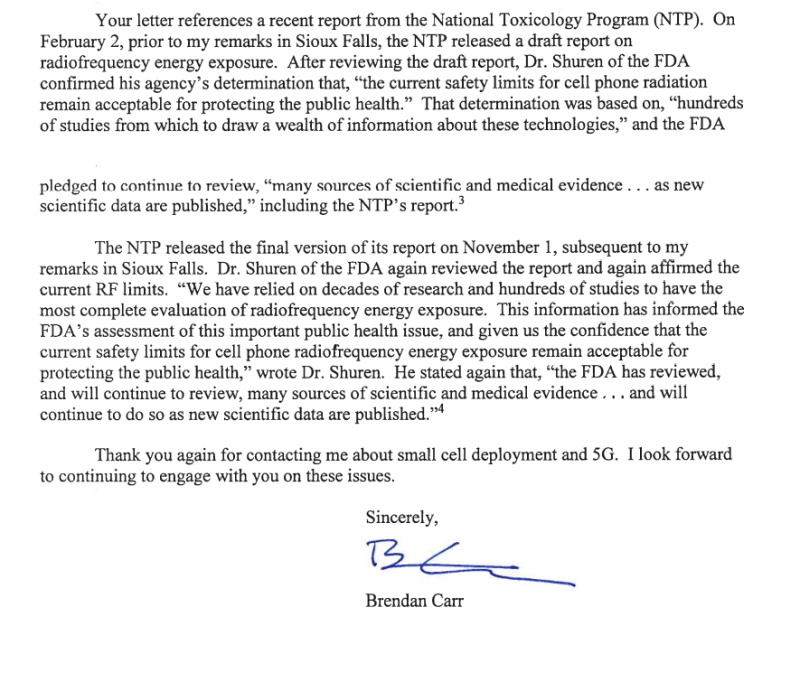
Key Assertions in Brendan Carr’s Letter on RF Radiation Safety Are Wrong
FCC and FDA Failures in Light of Scientific Evidence
Despite technological advancements and mounting scientific evidence highlighting the health risks associated with radiofrequency (RF) radiation, U.S. regulatory agencies like the FCC and FDA continue to rely on outdated safety standards established in 1996. A recent 2021 court ruling, spearheaded by Robert F. Kennedy Jr., exposed the inadequacies of these guidelines and invalidated claims of their sufficiency in protecting public health. The court found that the FCC failed to address a significant body of evidence demonstrating non-thermal biological effects, such as cancer, DNA damage, and oxidative stress.
The misleading assertions made by FCC Commissioner Brendan Carr in correspondence defending these obsolete standards. By dissecting claims of “decades of research” and “confidence in safety limits,” we reveal how these statements are inconsistent with the reality of stalled research, selective science, and regulatory capture. We also highlight key findings from groundbreaking studies like the National Toxicology Program (NTP) and Ramazzini Institute, which provide irrefutable evidence of RF radiation’s carcinogenic potential.
The abrupt halt of the NTP’s research, coupled with the FCC and FDA’s resistance to incorporating modern science, reflects a troubling pattern of prioritizing industry interests over public health. This calls for immediate action to update safety guidelines, restore independent research funding, and ensure accountability in regulatory practices to protect Americans—especially children—from the growing risks of wireless technology.
Key Assertions in Carr’s Letter

1. FDA’s Determination that Current Safety Limits are Acceptable
Carr cites Dr. Shuren of the FDA, claiming that the agency reviewed “decades of research and hundreds of studies” and found confidence in current safety limits for cell phone radiation. According to Carr, these safety limits were deemed acceptable for protecting public health.
The Reality:
- The 2021 U.S. Court of Appeals ruling contradicted this claim. The court found that the FCC failed to provide any updated scientific evidence to justify its outdated guidelines, which were established in 1996. These guidelines focus solely on thermal effects and ignore non-thermal biological effects, such as DNA damage, oxidative stress, and disruptions to bioelectric communication.
- Despite Carr’s assertion that the FDA had reviewed and relied on a wealth of scientific data, the court found no evidence to support that such reviews led to any meaningful updates in safety guidelines. The FCC and FDA were unable to produce substantive peer-reviewed research demonstrating the adequacy of their standards.
2. Continued Review of New Scientific Data
The letter suggests that the FDA and FCC are committed to ongoing review as “new scientific data are published,” referencing the National Toxicology Program (NTP) and other sources.
The Reality:
- While Carr points to the NTP’s research as evidence of ongoing review, the NTP study itself found clear evidence of cancer (gliomas and cardiac schwannomas) from RF radiation exposure. Instead of addressing these findings, the federal government under the Biden-Harris administration cut funding for further research. This demonstrates a move away from evidence-based policymaking, rather than the active review claimed in the letter.
- Additionally, the Ramazzini Institute study, which replicated the NTP findings at lower exposure levels, further confirmed the carcinogenic potential of RF radiation. These findings have not been reflected in any updated FCC or FDA guidelines.
3. Confidence in Current Safety Standards
The letter reassures that the current safety standards, based on research, are adequate to protect public health.
The Reality:
- The FCC’s guidelines have not been updated in over 25 years, despite significant advancements in wireless technology and research on RF radiation’s biological effects.
- The court emphasized that both the FCC and FDA failed to provide any substantive justification for retaining these outdated standards. The guidelines do not account for the non-thermal effects documented in thousands of peer-reviewed studies.
Breakdown of Misleading Statements
Misleading Claim #1: “Hundreds of studies” support the safety standards.
- While hundreds of studies exist, the FCC and FDA selectively ignore evidence of non-thermal effects, focusing only on studies that support the thermal paradigm of RF safety. The court’s findings directly contradict this assertion, as no credible evidence was provided to justify the adequacy of the 1996 guidelines.
Misleading Claim #2: The FDA continues to review new data.
- The court found no evidence of proactive, meaningful review by the FDA. In fact, the halting of the NTP study underscores a lack of commitment to understanding RF radiation risks.
Misleading Claim #3: Current safety limits are protective of public health.
- The outdated guidelines do not reflect modern scientific understanding of RF radiation. By failing to account for non-thermal effects, the FCC’s standards leave the public vulnerable to potential health risks, including cancer, neurological disorders, and reproductive harm.
The Truth and Reality
- Court Findings:
- The 2021 court ruling invalidated the FCC’s claim that their safety guidelines adequately protect public health. The court noted that the FCC failed to address a substantial body of evidence pointing to non-thermal biological effects.
- Stalled Research:
- Instead of acting on the NTP’s alarming findings, the federal government halted further research. This move contradicts the letter’s assurance of ongoing scientific review.
- Regulatory Capture:
- The telecommunications industry has had significant influence over regulatory agencies like the FCC. This has resulted in a lack of accountability and failure to prioritize public health over corporate interests.
Call to Action: Public Accountability
The American people deserve transparency and action from their regulatory agencies. Letters like this one, while reassuring on the surface, mislead the public about the true state of RF radiation safety. The 2021 court ruling makes it clear that the current guidelines are insufficient and outdated, putting public health—especially children’s health—at risk.
It is time to:
- Demand Updated Guidelines: Agencies like the FCC and FDA must revise safety standards to reflect modern science.
- Insist on Independent Research: Funding must be restored for independent studies on RF radiation’s biological effects.
- Hold Regulators Accountable: Policymakers must prioritize public health over industry profits.
The FCC and FDA can no longer ignore the overwhelming scientific evidence of RF radiation’s risks. Public awareness and advocacy are critical to ensuring the health and safety of future generations.







